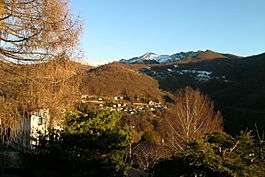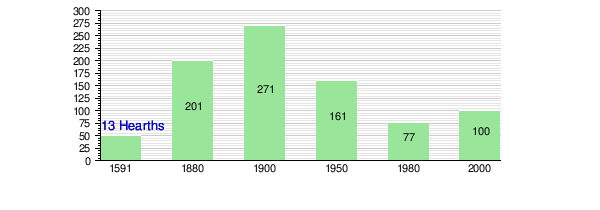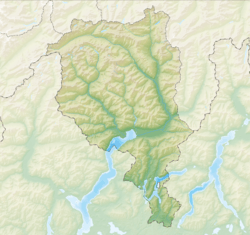Cimadera facts for kids
Quick facts for kids
Cimadera
|
||
|---|---|---|
 |
||
|
||
| Country | Switzerland | |
| Canton | Ticino | |
| District | Lugano | |
| Area | ||
| • Total | 5.28 km2 (2.04 sq mi) | |
| Elevation | 1,084 m (3,556 ft) | |
| Population
(Dec 2011)
|
||
| • Total | 115 | |
| • Density | 21.78/km2 (56.41/sq mi) | |
| Postal code |
6951
|
|
| Surrounded by | Certara, Sonvico, Valcolla, Val Rezzo (Italy), Valsolda (Italy) | |
Cimadera was a small town in Switzerland, located in the Lugano district within the Ticino region. It was once an independent municipality, but on April 14, 2013, it joined with several other towns. These included Bogno, Cadro, Carona, Certara, Valcolla, and Sonvico. All of them became part of the larger city of Lugano.
Contents
History of Cimadera
Cimadera is first mentioned in old records from 1422. It was originally a camp for herding animals, used by people from a village called Treciore. After a serious illness spread in 1525, people decided to live in Cimadera permanently.
In the 16th century, Cimadera was part of the larger area and church parish of Sonvico. In 1878, Cimadera became its own independent municipality and parish. This meant it could manage its own affairs.
Two important chapels were built in Cimadera. The chapel of St. Anthony of Padua dates back to the 17th century. The prayer house of S. Maria ed Elisabetta was built in 1670.
For a long time, people in Cimadera made their living mainly from farming and raising cattle. Some people also left the village for parts of the year to find work elsewhere. Since the early 1900s, fewer people have worked in farming. Many people moved closer to Lugano for jobs. This caused the town's population to shrink. Today, many houses in Cimadera are used as vacation homes.
Geography of Cimadera
Before it merged with Lugano, Cimadera covered an area of about 5.2 square kilometers (2 square miles). A small part, about 5.9%, was used for farming. Most of the land, about 83.3%, was covered by forests.
Only a small area, about 1.7%, had buildings or roads. The rest, about 4%, was unproductive land, meaning it couldn't be used for farming or building.
Cimadera is located on the left side of the upper Val Colla valley. It sits at an elevation of about 1,100 meters (3,600 feet) above sea level.
Cimadera's Coat of Arms
A coat of arms is a special design that represents a town or family. The coat of arms for Cimadera has a unique design. It features two red towers on a background that is blue at the top and silver at the bottom.
People of Cimadera
In 2011, Cimadera had a population of 115 people. A small percentage of the population were foreign nationals. Over ten years, from 1997 to 2007, the population grew by about 17.3%.
Most people in Cimadera speak Italian, which is 85% of the population. German is the second most common language, spoken by 10% of the people. A small number, 2%, speak French.
In 2008, there were slightly more men than women in Cimadera. The population included 62 Swiss men and 5 non-Swiss men. There were 60 Swiss women and 3 non-Swiss women.
The age groups in Cimadera in 2009 showed that about 5.4% of the population were children under 9 years old. Teenagers aged 10 to 19 made up 6.2%. Adults between 20 and 59 years old made up a larger portion of the population. About 37% of the population was 60 years old or older.
In 2000, there were 55 private homes in Cimadera, with an average of 1.8 people living in each home. Most of the buildings were single-family homes. Many apartments in Cimadera were used only during certain seasons, like for vacations.
The chart below shows how the population of Cimadera has changed over time:

Sights in Cimadera
The entire village of Cimadera is recognized as an important Swiss Heritage Site. This means it has special historical or cultural value.
Economy of Cimadera
In 2007, Cimadera had a low unemployment rate of 3.25%. The town's economy involved a few different types of work.
- Primary sector: This includes jobs like farming and forestry. In 2005, 3 people worked in this sector.
- Secondary sector: This involves manufacturing and construction. 6 people worked in this sector.
- Tertiary sector: This includes service jobs, like in shops or offices. 3 people worked in this sector.
In 2000, 5 workers came into Cimadera for work, while 29 workers left the town to work elsewhere. This means more people left Cimadera for work than came in. Most people used a private car to get to work.
Religion in Cimadera
According to the 2000 census, most people in Cimadera were Roman Catholic, making up 79% of the population. About 9% belonged to the Swiss Reformed Church. A small number of people belonged to other churches or did not state their religion.
Education in Cimadera
Switzerland is known for its good education system. In Cimadera, about 75.8% of adults aged 25-64 had completed higher education. This means they finished either upper secondary school or went on to university.
In 2009, there were 10 students in Cimadera. The education system in Ticino, where Cimadera is located, offers up to three years of non-mandatory kindergarten. After that, there are five years of mandatory primary school. In Cimadera, 3 students attended primary school.
For middle school, students can choose between a two-year program or a four-year program that prepares them for higher education. In Cimadera, 2 students were in the two-year middle school program.
After middle school, students can enter vocational training. This prepares them for a specific trade or job. In 2009, 1 student was attending vocational school full-time, and 4 students were attending part-time.
In 2000, 6 students from Cimadera attended schools outside of the municipality.
See also
 In Spanish: Cimadera para niños
In Spanish: Cimadera para niños




